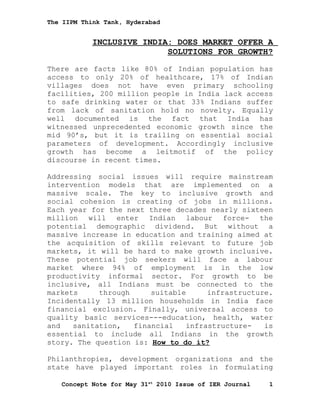
Concept Note
- 1. The IIPM Think Tank, Hyderabad INCLUSIVE INDIA: DOES MARKET OFFER A SOLUTIONS FOR GROWTH? There are facts like 80% of Indian population has access to only 20% of healthcare, 17% of Indian villages does not have even primary schooling facilities, 200 million people in India lack access to safe drinking water or that 33% Indians suffer from lack of sanitation hold no novelty. Equally well documented is the fact that India has witnessed unprecedented economic growth since the mid 90’s, but it is trailing on essential social parameters of development. Accordingly inclusive growth has become a leitmotif of the policy discourse in recent times. Addressing social issues will require mainstream intervention models that are implemented on a massive scale. The key to inclusive growth and social cohesion is creating of jobs in millions. Each year for the next three decades nearly sixteen million will enter Indian labour force- the potential demographic dividend. But without a massive increase in education and training aimed at the acquisition of skills relevant to future job markets, it will be hard to make growth inclusive. These potential job seekers will face a labour market where 94% of employment is in the low productivity informal sector. For growth to be inclusive, all Indians must be connected to the markets through suitable infrastructure. Incidentally 13 million households in India face financial exclusion. Finally, universal access to quality basic services---education, health, water and sanitation, financial infrastructure- is essential to include all Indians in the growth story. The question is: How to do it? Philanthropies, development organizations and the state have played important roles in formulating Concept Note for May 31st 2010 Issue of IER Journal 1
- 2. The IIPM Think Tank, Hyderabad and implementing solutions to some of these issues. But for a variety of reasons, significant success has eluded them so far. So influential thinkers are proposing an alternative model. For a continent size country like India, inclusive growth makes for a sound business decision. This should encourage private enterprises to meet market demand by servicing under penetrated markets with customized and cost effective products, leveraging the potential of untapped resources while enhancing social benefits. Truly sustainable inclusive growth requires intervention models implemented on a large scale using efficient scalable mechanisms to enhance impact. While state and the not for profit agencies continue to work, the role of the private sector becomes critical given that it embodies attributes such as sustainability, efficiency, and scale that are vital to make a difference. While the government is expected to play a key role in broadening access to economic opportunities and build resilience of the most vulnerable against economic shocks, the market driven forces of growth should be able to access the social sector through marketization of these activities. But as ever, the dissenting voices say it is akin to abdication of the responsibility of the state towards correcting the market failure. We need more state here, not less. We invite your valued arguments. Please feel free to approach for any other additional information at m.chaitanya@iipm.edu Concept Note for May 31st 2010 Issue of IER Journal 2
